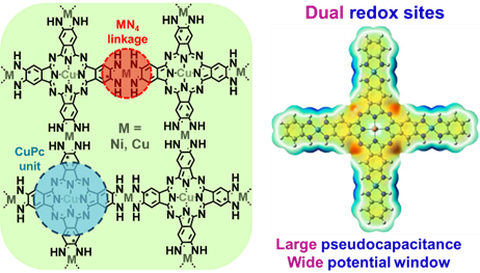Jul 13, 2021
Dual-Redox-Sites Enable Two-Dimensional Conjugated Metal–Organic Frameworks with Large Pseudocapacitance and Wide Potential Window
Advanced supercapacitor electrodes require the development of materials with dense redox-sites embedded into conductive and porous skeletons. Two-dimensional (2D) conjugated metal-organic frameworks (c-MOFs) are attractive supercapacitor electrode materials due to their high intrinsic electrical conductivities, large specific surface areas, and quasi-one-dimensional aligned pore arrays. However, the reported 2D c-MOFs still suffer from unsatisfying specific capacitances and narrow potential windows because large and redox-inactive building blocks lead to low redox-site densities of 2D c-MOFs.
The researchers from Prof. Xinliang Feng’s group recently demonstrated the dual-redox-site 2D c-MOFs with copper phthalocyanine building blocks linked by metal-bis(iminobenzosemiquinoid) (M2[CuPc(NH)8], M = Ni or Cu), which depict both large specific capacitances and wide potential windows. Experimental results accompanied by theoretical calculations verify that phthalocyanine monomers and metal-bis(iminobenzosemiquinoid) linkages serve as respective redox sites for pseudocapacitive cation (Na+) and anion (SO42-) storage, enabling the continuous Faradaic reactions of M2[CuPc(NH)8] occurring in a large potential window of −0.8 ~ 0.8 V vs. Ag/AgCl (3 M KCl). The decent conductivity (0.8 S m−1) and high active-site density further endow the Ni2[CuPc(NH)8] with a remarkable specific capacitance (400 F g−1 at 0.5 A g−1) and excellent rate capability (183 F g−1 at 20 A g−1). Quasi-solid-state symmetric supercapacitors are further assembled to demonstrate the practical application of Ni2[CuPc(NH)8] electrode, which deliver a state-of-the-art energy density of 51.6 Wh kg−1 and a peak power density of 32.1 kW kg−1. This work provides insightful guidelines for exploring the multielectron Faradaic reactions in new porous framework materials, which will benefit the development of next-generation energy storage technologies.
Reference: Panpan Zhang, Mingchao Wang, Yannan Liu, Sheng Yang, Faxing Wang, Yang Li, Guangbo Chen, Zichao Li, Gang Wang, Minshen Zhu, Renhao Dong, Minghao Yu, Oliver G Schmidt, Xinliang Feng. Dual-Redox-Sites Enable Two-Dimensional Conjugated Metal–Organic Frameworks with Large Pseudocapacitance and Wide Potential Window. J. Am. Chem. Soc. 2021, https://pubs.acs.org/doi/abs/10.1021/jacs.1c03039
Acknowledgments: This work was financially supported by European Union’s Horizon 2020 research and innovation programme (GrapheneCore3 881603), ERC Consolidator grant (T2DCP 819698), ERC Starting grant (FC2DMOF, No. 852909), Deutsche Forschungsgemeinschaft (MX‐OSMOPED), M-ERA.NET and Sächsisches Staatsministerium für Wissenschaft und Kunst (HYSUCAP 100478697), German Research Foundation (DFG) within the Cluster of Excellence, CRC 1415 (grant no. 417590517), Polymer-based Batteries (SPP 2248, RACOF-MMIS), and Coordination Networks: Building Blocks for Functional Systems (SPP1928, COORNETs). We appreciate Dr. Mao Wang for the conductivity measurements and thank Dr. Yulia Krupskaya (IFW Dresden) for EPR measurement. We acknowledge the use of the facilities in Dresden Center for Nanoanalysis at Technische Universität Dresden. The authors thank the Center for Information Services and High Performance Computing (ZIH) at TU Dresden for generous allocations of computer time.

